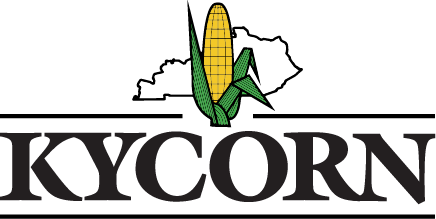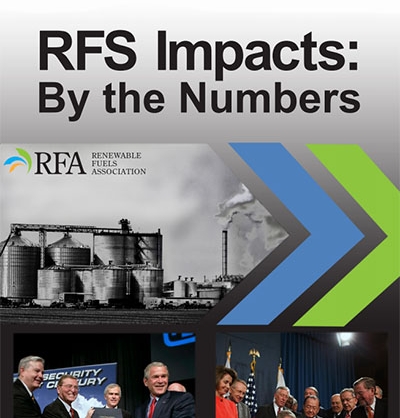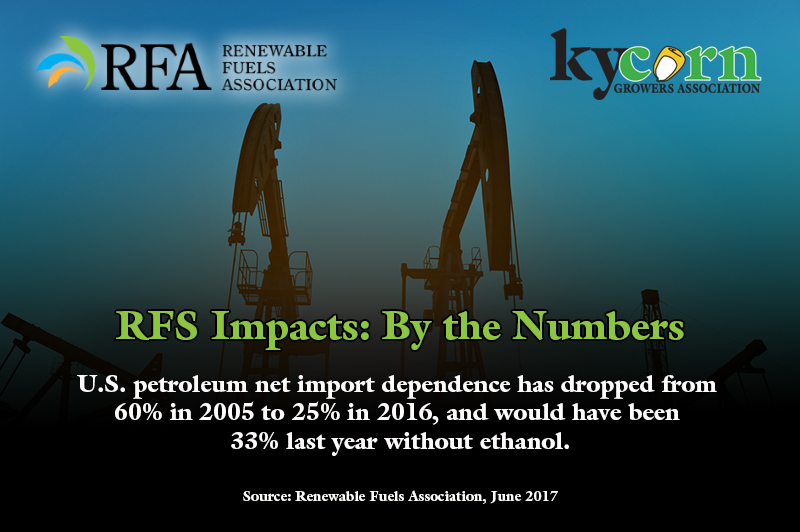(Renewable Fuels Association) More than a decade after the original renewable fuel standard (RFS) was signed into law, tremendous progress has been made toward its goals of energy security, clean air and boosting local economies, according to a new analysis by the Renewable Fuels Association, “RFS Impacts: By the Numbers.” The analysis comes as EPA is expected to soon issue its proposed 2018 renewable volume obligations (RVOs) under the RFS.
Congress adopted the RFS in 2005 and expanded it in 2007. The program requires oil companies to blend increasing volumes of renewable fuels with gasoline and diesel, culminating with 36 billion gallons in 2022.
“The data show that by any objective measure, the RFS has been a tremendous success,” according to the analysis, which looks at data on how the world has changed since adoption of the RFS. Specifically, the analysis compares key data points and indicators from 2005 and 2007 to data from 2016.
Among the highlights:
- The number of operational U.S. ethanol plants has grown from 81 in 2005 to 213 in 2016, while ethanol production has grown from 3.9 billion gallons to 15.3 billion gallons, a nearly 300% increase;
- U.S. ethanol industry jobs grew 121 percent from 153,725 in 2005 to 339,176 in 2016, and the value of the industry’s output quadrupled from $8.1 billion to $32.8 billion;
- U.S. corn production has grown from 11.1 billion bushels in 2005 to 15.2 billion gallons in 2016, a 36 percent increase, while average yields grew from 147.9 bushels per acre to 174.6 bushels per acre;
- U.S. petroleum net import dependence has dropped from 60% in 2005 to 25% in 2016, and would have been 33% last year without ethanol;
- The number of retail gasoline stations offering flex fuels like E85 to flexible fuel vehicles (FFVs) grew 728 percent from 2005 to 2016, while the number of FFVs on the road grew 239 percent; and
- Ethanol’s role in cleaning the air has increased, with notable reductions in emissions of both greenhouse gases and criteria pollutants.
Meanwhile, the negative outcomes that opponents of the RFS suggested would occur simply have not materialized:
- Corn acres in 2016 were only 0.5 percent larger than in 2007, while total cropland was down more than 20 million acres (5 percent);
- Corn prices in 2016 were actually 19% lower than in 2007, while the corn surplus was 42% larger;
- Water use for irrigating corn trended lower, while the size of the Gulf hypoxia zone shrunk 14 percent between 2007 and 2016;
- Deforestation in the Amazon fell 58 percent between 2005 and 2016;
- Retail food price inflation was just 0.3 percent in 2016, compared to 2.4 percent in 2005 and 4 percent in 2007;
- Prices for red meat, poultry, fish, cereals and bakery items, and dairy actually experienced price deflation in 2016, compared to modest inflation in 2005 and 2007;
- U.S. milk production in 2016 was 20 percent higher than 2005, while red meat and poultry production was up 12 percent; and
- The U.N. global food price index was just 0.1 percent higher in 2016 than it was in 2007, while the number of people undernourished worldwide was down 16 percent.
“As this analysis clearly shows, the RFS has made a huge impact on consumers, providing them with greater choice at the pump, while cleaning the air and boosting local economies,” said RFA President and CEO Bob Dinneen. “With EPA expected to propose its 2018 RFS obligations in the near future, the agency needs to look no further than this document for what impact this vital program has had on our nation. We look forward to EPA continuing to implement a strong RFS to ensure future growth for our industry and the positive impact it has throughout all sectors of our economy.”
The full analysis is available here.


